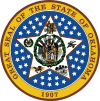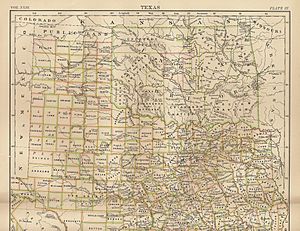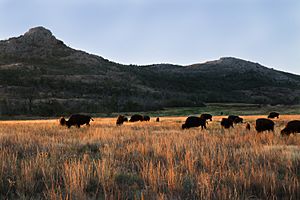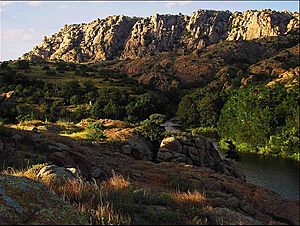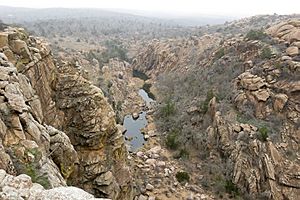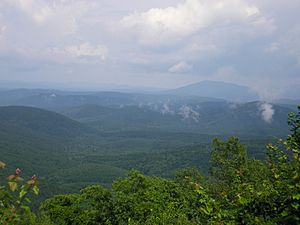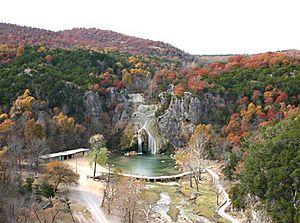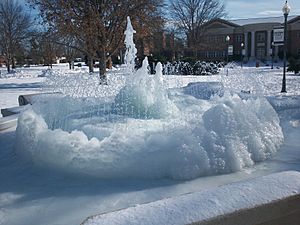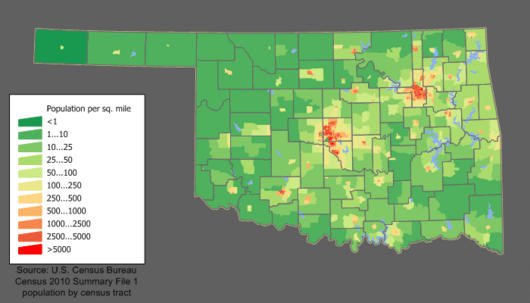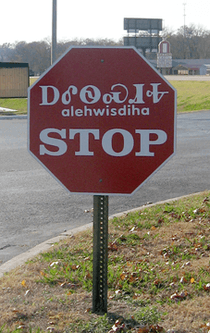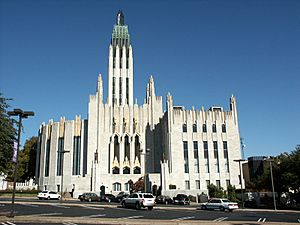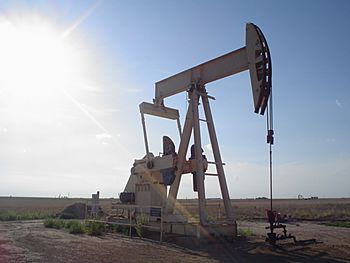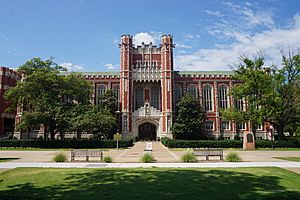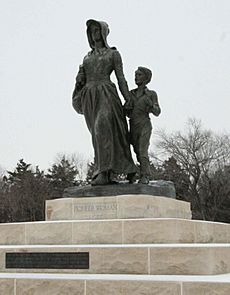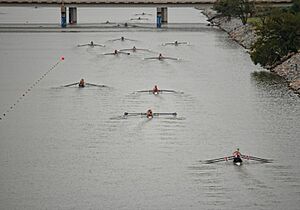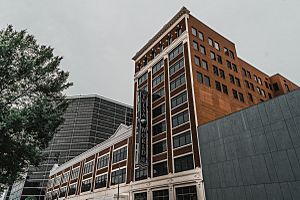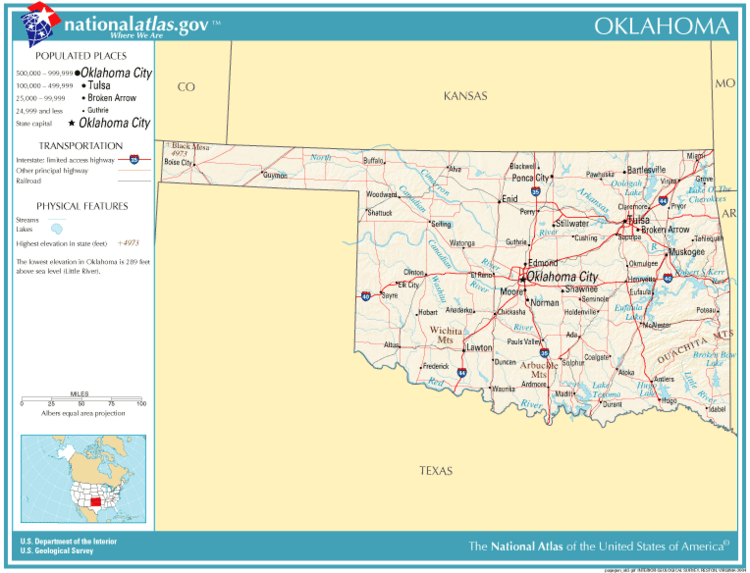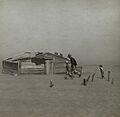Oklahoma facts for kids
Quick facts for kids
Oklahoma
Oklahumma (Choctaw)
|
|||
|---|---|---|---|
|
|||
Nickname(s):
|
|||
| Motto(s):
Labor omnia vincit
(English: Work conquers all) |
|||
| Anthem: "Oklahoma" and "Oklahoma Hills" |
|||

Location of Oklahoma within the United States
|
|||
| Country | United States | ||
| Before statehood |
|
||
| Admitted to the Union | November 16, 1907 (46th) | ||
| Capital (and largest city) |
Oklahoma City | ||
| Largest county or equivalent | Oklahoma | ||
| Largest metro and urban areas | Greater Oklahoma City | ||
| Legislature | Oklahoma Legislature | ||
| • Upper house | Senate | ||
| • Lower house | House of Representatives | ||
| Judiciary | Oklahoma Supreme Court (civil) Oklahoma Court of Criminal Appeals (criminal) |
||
| U.S. senators |
|
||
| U.S. House delegation | 5 Republicans (list) | ||
| Area | |||
| • Total | 69,699 sq mi (180,519 km2) | ||
| • Land | 68,595 sq mi (177,660 km2) | ||
| • Water | 1,304 sq mi (3,377 km2) 1.9% | ||
| Area rank | 20th | ||
| Dimensions | |||
| • Length | 468 mi (756 km) | ||
| • Width | 230 mi (370 km) | ||
| Elevation | 1,300 ft (400 m) | ||
| Highest elevation | 4,975 ft (1,516 m) | ||
| Lowest elevation
(Little River at Arkansas border)
|
289 ft (88 m) | ||
| Population
(2024)
|
|||
| • Total | |||
| • Rank | 28th | ||
| • Density | 55.20/sq mi (21.30/km2) | ||
| • Density rank | 34th | ||
| • Median household income | $62,100 (2023) | ||
| • Income rank | 43rd | ||
| Demonym(s) | Oklahoman; Okie (colloq., historically derogatory); Sooner (historically) |
||
| Language | |||
| • Official language | English, Choctaw, Cherokee | ||
| Time zones | |||
| entire state (legally) | UTC−06:00 (Central) | ||
| • Summer (DST) | UTC−05:00 (CDT) | ||
| Kenton (informally) | UTC−07:00 (Mountain) | ||
| • Summer (DST) | UTC−06:00 (MDT) | ||
| USPS abbreviation |
OK
|
||
| ISO 3166 code | US-OK | ||
| Traditional abbreviation | Okla. | ||
| Latitude | 33°37' N to 37° N | ||
| Longitude | 94° 26' W to 103° W | ||
Oklahoma ( OHK-lə-HOH-mə; Choctaw: Oklahumma) is a state in the South Central part of the United States. It shares borders with Texas, Kansas, Missouri, Arkansas, New Mexico, and Colorado. Oklahoma is the 20th largest state by area and the 28th largest by population. People from Oklahoma are called Oklahomans. Its capital and largest city is Oklahoma City.
The state's name comes from the Choctaw words okla, meaning 'people', and humma, meaning 'red'. Oklahoma is also known as "The Sooner State." This nickname refers to the "Sooners," settlers who claimed land before it was officially opened during the Land Rush of 1889.
Oklahoma has old mountain ranges, prairies, flat-topped hills called mesas, and eastern forests. Most of the state is in the Great Plains and U.S. Interior Highlands. These areas often experience severe weather. Oklahoma is a meeting point of three major American cultural regions. It was historically a territory for American Indians who were moved from east of the Mississippi River. It was also a route for cattle drives and a place where Southern settlers moved. Today, 26 different Native American languages are spoken here. About 14.2% of Oklahomans identify as American Indians. This is the highest percentage of indigenous people in any U.S. state.
Oklahoma is a big producer of natural gas, oil, and farm products. Its economy also relies on aviation, energy, telecommunications, and biotechnology. Oklahoma City and Tulsa are the main economic centers. Almost two-thirds of Oklahomans live in these areas.
Contents
- What's in a Name? The Meaning of Oklahoma
- Oklahoma's Past: A Look at History
- Exploring Oklahoma's Geography
- How Oklahoma is Governed
- Oklahoma's People: Demographics
- Oklahoma's Economy: How People Make a Living
- Learning in Oklahoma: Education
- Oklahoma's Culture and Traditions
- News and Media in Oklahoma
- Getting Around: Transportation in Oklahoma
- Oklahoma's State Symbols
- Images for kids
- See also
What's in a Name? The Meaning of Oklahoma
The name Oklahoma comes from the Choctaw language. The word okla means 'people', and humma means 'red'. So, Oklahoma means 'red people'. Allen Wright, a Chief of the Choctaw Nation, suggested this name in 1866. He was talking with the U.S. government about using Indian Territory. He imagined a state just for American Indians. Oklahoma later became the common name for the area. It was officially approved in 1890.
Oklahoma's Past: A Look at History
People have lived in what is now Oklahoma since the last ice age. Ancestors of tribes like the Wichita, Kichai, and Caddo lived here. The Spiro Mounds in eastern Oklahoma was a major center for the Mississippian culture between AD 850 and 1450.
Early Explorers and the Louisiana Purchase
The Spanish explorer Francisco Vázquez de Coronado traveled through the state in 1541. However, French explorers claimed the area in the 1700s. In the 18th century, the Kiowa, Apache, and Comanche tribes moved into the region. The French owned this land until 1803. Then, the United States bought it as part of the Louisiana Purchase.
Indian Territory and the Trail of Tears
During the 1800s, many Native Americans were forced to leave their homes. They were moved to the area that became Oklahoma. This forced journey is known as the "Trail of Tears." The Choctaw were one of the first tribes to be moved in 1831. By 1890, more than 30 Native American nations and tribes lived in Indian Territory.
Cattle Trails and Land Runs
After the American Civil War, cattle ranches in Texas needed to get their beef to eastern cities. So, cattle trails developed through Indian Territory. Cowboys drove their cattle north. By 1881, four of the five main cattle trails crossed this territory.
More white settlers started moving into Indian Territory. This led to the Dawes Act in 1887. This law divided tribal lands into smaller plots for individual families. It also took land for the federal government and railroad companies.
Major land runs were held to open land for settlement. The most famous was the Land Rush of 1889. Settlers had to wait for a precise start time. Those who crossed the border "sooner" than allowed were called "sooners." This is how Oklahoma got its nickname.
Becoming a State and Modern Times
Discussions to make Oklahoma a state began in the late 1800s. On November 16, 1907, Oklahoma officially became the 46th state in the U.S.
The new state quickly became important for the oil industry. New oil discoveries made towns grow fast and become wealthy. Tulsa was even called the "Oil Capital of the World" for much of the 20th century. Oil money helped Oklahoma's early economy. In 1927, Oklahoman businessman Cyrus Avery helped create U.S. Route 66. He is known as the "Father of Route 66."
Oklahoma also has a rich African American history. Many black towns thrived in the early 1900s. People moved from nearby states like Kansas. The Greenwood neighborhood in Tulsa was a very successful African-American community.
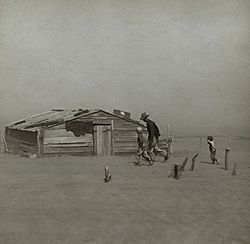
In the 1930s, parts of Oklahoma suffered from the Dust Bowl. This was caused by poor farming, long droughts, and strong winds. Thousands of farmers became poor and had to move away. The state's population even dropped between 1930 and 1950.
After the Dust Bowl, Oklahoma focused on soil and water conservation. They built many dams and artificial lakes. By the 1960s, Oklahoma had over 200 lakes, more than any other state.
Exploring Oklahoma's Geography
Oklahoma is the 20th largest state in the U.S. It covers about 69,898 square miles (181,035 km²). It is located in the Great Plains region. Oklahoma borders Arkansas, Missouri, Kansas, Colorado, New Mexico, and Texas. The Red River forms much of its border with Texas.
The western edge of the Oklahoma panhandle is slightly off from its Texas border. This is because of an old surveying error from 1819. Cimarron County in the panhandle is unique. It is the only county in the U.S. that touches four other states: New Mexico, Texas, Colorado, and Kansas.
Land Features and Mountains

Oklahoma's land generally slopes from west to east. The highest point is Black Mesa, at 4,973 feet (1,516 m) above sea level. It is in the far northwest. The lowest point is on the Little River, at 289 feet (88 m) above sea level. This is near the southeastern border.
Oklahoma is one of the most geographically diverse states. It has 11 different ecological regions. This is more per square mile than any other state.
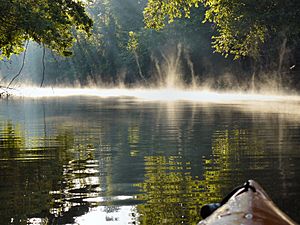
Oklahoma has four main mountain ranges: the Ouachita Mountains, the Arbuckle Mountains, the Wichita Mountains, and the Ozark Mountains. These mountains are part of the U.S. Interior Highlands. A small part of the Flint Hills also reaches into north-central Oklahoma. Cavanal Hill is sometimes called the world's tallest hill. It is 1,999 feet (609 m) tall.
The semi-arid high plains in the northwest have few natural forests. This area has rolling or flat land with canyons and mesas. The Glass Mountains are an example. Central Oklahoma has prairies and oak savannahs. The Ozark and Ouachita Mountains are in the eastern part of the state.
Oklahoma has over 500 named creeks and rivers. It also has 200 lakes created by dams. This gives it the most artificial reservoirs in the nation. Most of the state's water flows into the Red and Arkansas rivers.
Plants and Animals: Oklahoma's Biodiversity

Oklahoma has a high variety of plants and animals for its size. This is because it is where many different geographic regions meet. Forests cover about 24% of Oklahoma. Prairie grasslands are found in the central and western parts of the state. These include shortgrass, mixed-grass, and tallgrass prairie.
In the drier western regions, you'll find shortgrass prairie and shrublands. Pinyon pines and ponderosa pines grow near rivers in the panhandle. Southwestern Oklahoma has rare species like sugar maple and southern live oak.
Marshlands, cypress forests, and pine forests are common in the southeastern part of the state. Deciduous forests, with trees like post oak and elm, cover northeastern Oklahoma.
Oklahoma is home to many animals. These include white-tailed deer, mule deer, antelope, coyotes, mountain lions, and bobcats. Birds like quail, doves, cardinals, and bald eagles are also found here. In the prairies, you can see American bison, greater prairie chickens, and badgers. Some of the largest prairie dog towns are in the panhandle. The Cross Timbers region has 351 different vertebrate species. The Ouachita Mountains have black bears, red foxes, and river otters. The American alligator also lives in southeastern Oklahoma.
Protected Natural Areas
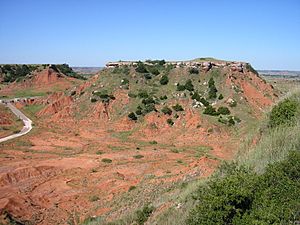
Oklahoma has 50 state parks and six national parks or protected areas. It also has two national forests or grasslands. These areas protect wildlife and nature. Six percent of Oklahoma's forests are public land. This includes parts of the Ouachita National Forest, which is the largest and oldest national forest in the Southern United States.
The Tallgrass Prairie Preserve in north-central Oklahoma is the largest protected area of tallgrass prairie in the world. It covers 39,000 acres (158 km²). The Black Kettle National Grassland covers 31,300 acres (127 km²) in southwestern Oklahoma. The Wichita Mountains Wildlife Refuge is the oldest and largest wildlife refuge in the state. It was founded in 1901.
Some of Oklahoma's federally protected sites include the Chickasaw National Recreation Area. Others are the Santa Fe and Trail of Tears national historic trails. The Oklahoma City National Memorial is also a protected site.
Oklahoma's Weather and Climate
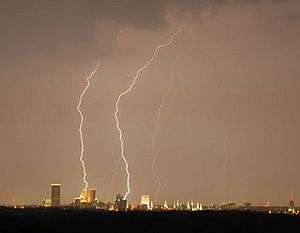
Oklahoma has a humid subtropical climate. It is in a special zone called Tornado Alley. Here, cold, dry air from Canada, warm, dry air from Mexico, and warm, moist air from the Gulf of Mexico often meet. This mix creates severe weather, including thunderstorms, strong winds, large hail, and tornadoes. On average, 62 tornadoes hit Oklahoma each year. This is one of the highest rates in the world.
Because of these different air currents, Oklahoma's weather can change very quickly. For example, on November 11, 1911, the temperature in Oklahoma City reached 83°F (28°C). But by midnight, it dropped to 17°F (-8°C)! Both the record high and record low for that date were set on the same day.
Winter is usually the driest season in Oklahoma. Rainfall increases in the spring, with May being the wettest month. Early summer can be wet, but July and August are often dry and hot. Severe droughts can happen in the summer. Precipitation increases again in the fall, then drops in late autumn and winter.
Temperatures can go above 100°F (38°C) or below 0°F (-18°C) in Oklahoma. However, below-zero temperatures are rare in the south. Snowfall varies from less than 4 inches (10 cm) in the south to over 20 inches (51 cm) in the panhandle.
How Oklahoma is Governed
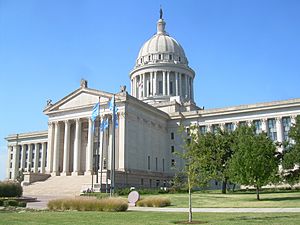
Oklahoma is a constitutional republic. Its government is like the federal government of the United States. It has executive, legislative, and judicial branches. The state has 77 counties. These counties handle most local government tasks.
State Government Structure
The Oklahoma Legislature makes the state's laws. It has two parts: the Oklahoma Senate and the Oklahoma House of Representatives. The Senate has 48 members who serve four-year terms. The House has 101 members who serve two-year terms. There is a term limit for lawmakers. No one can serve more than 12 years in both parts of the legislature combined.
Oklahoma's judicial branch includes the Oklahoma Supreme Court and the Oklahoma Court of Criminal Appeals. There are also 77 District Courts, one for each county. The Supreme Court handles civil cases, and the Court of Criminal Appeals handles criminal cases. This split system is only found in Oklahoma and Texas. Judges are chosen by the governor and then voted on by the public every six years.
The executive branch is led by the governor. The governor is the chief executive and leads the Oklahoma National Guard when it's not used by the federal government. The governor can also veto bills passed by the legislature. The executive branch makes sure state laws are followed and keeps peace in the state.
Local Government and Tribal Nations
Oklahoma is divided into 77 counties. Each county has a council of three elected commissioners. They also have a tax assessor, clerk, court clerk, treasurer, and sheriff. Cities and towns have their own local governments. County governments oversee both cities and rural areas. Both county and city governments collect taxes, have police forces, and run emergency services.
Thirty-nine Native American tribal governments are based in Oklahoma. These tribes have special powers within their designated areas. Unlike other states, Oklahoma does not have large Indian reservations. However, tribal governments have land from the Indian Territory era. They have powers over their tribal members and activities. The United States Congress can change these powers.
Oklahoma's People: Demographics
| Historical population | |||
|---|---|---|---|
| Census | Pop. | %± | |
| 1890 | 258,657 | — | |
| 1900 | 790,391 | 205.6% | |
| 1910 | 1,657,155 | 109.7% | |
| 1920 | 2,028,283 | 22.4% | |
| 1930 | 2,396,040 | 18.1% | |
| 1940 | 2,336,433 | −2.5% | |
| 1950 | 2,233,513 | −4.4% | |
| 1960 | 2,328,284 | 4.2% | |
| 1970 | 2,559,229 | 9.9% | |
| 1980 | 3,025,290 | 18.2% | |
| 1990 | 3,145,585 | 4.0% | |
| 2000 | 3,450,654 | 9.7% | |
| 2010 | 3,751,675 | 8.7% | |
| 2020 | 3,959,353 | 5.5% | |
| 2023 (est.) | 4,053,824 | 8.1% | |
| U.S. Decennial Census | |||
Oklahoma's population has grown steadily. In 2010, it was 3,751,675 people. By 2020, it grew to 3,959,353. In 2022, the population passed 4 million for the first time. Oklahoma had the second-largest population increase in the South Central region from 2010 to 2020, after Texas.
Diversity in Oklahoma
Oklahoma is a diverse state. In 2010, about 72.2% of the population was white. About 8.6% were American Indian or Alaska Native. African Americans made up 7.4%, and Asians were 1.7%. About 8.9% of Oklahomans were of Hispanic or Latino origin. People of Hispanic origin can be of any race.
Many Oklahomans have German, American, Irish, English, African American, and Native American roots. About 11.4% of people reported Native American ancestry.
Languages Spoken in Oklahoma
English has been the official language of Oklahoma since 2010. Most people in Oklahoma speak English at home.
Oklahoma has the second-highest number of Native American languages spoken in the U.S., after California. Twenty-five Native American languages are spoken here. The most common are Cherokee and Choctaw. About 10,000 Cherokee speakers live in eastern Oklahoma. Another 10,000 Choctaw speakers live south of the Cherokees. Cherokee is an official language in the Cherokee Nation.
Spanish is the second most common language in Oklahoma, after English. Other languages spoken include German, Vietnamese, and French.
Religious Beliefs in Oklahoma
Oklahoma is part of the "Bible Belt." This region in the southern and eastern U.S. is known for conservative Christian views. Many people in Oklahoma are Evangelical Protestants. Tulsa, the state's second-largest city, is sometimes called the "buckle of the Bible Belt."
In 2014, about 79% of Oklahomans identified as Christian. Evangelical Protestants were the largest group, at 47%. The number of people who said they were unaffiliated with any religion increased to 18%. Other religions in the state include Catholicism, Mormonism, Buddhism, Hinduism, and Islam.
Oklahoma's Economy: How People Make a Living
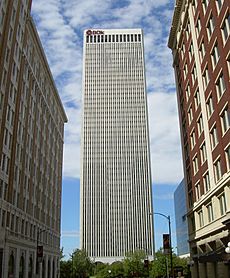
Oklahoma's economy includes many different areas. These include aviation, energy, transportation, food processing, and telecommunications. Oklahoma is a major producer of natural gas, aircraft, and food. It ranks third in the U.S. for natural gas production and fifth for wheat.
Several large companies have their main offices in Oklahoma. The state is known as one of the most business-friendly states. It had the 7th lowest tax burden in 2007.
Oklahoma's total economic output was $254.13 billion in 2023. The average income per person was $58,499 in 2023. Oklahoma also has one of the lowest costs of living in the nation.
Oil has always been important to Oklahoma's economy. However, a drop in oil prices in the 1980s caused many job losses. In 2007, oil contributed $35 billion to Oklahoma's economy. But other industries now employ more people. In September 2020, the state's unemployment rate was 5.3%.
Major Industries in Oklahoma
Oklahoma has a civilian workforce of about 1.7 million people. The government sector provides the most jobs. Other big job areas include transportation, utilities, education, business, and manufacturing. The aerospace industry brings in $11 billion each year.
Tulsa has the world's largest airline maintenance base for American Airlines. Aerospace makes up over 10% of Oklahoma's industrial output. The state is also a top manufacturer of tires in North America. It has one of the fastest-growing biotechnology industries. In 2005, Oklahoma's manufacturing exports were $4.3 billion.
Energy Production in Oklahoma
Oklahoma is the third-largest producer of natural gas in the U.S. It is also the fifth-largest producer of crude oil. The state has the second-highest number of active drilling rigs. In 2011, Oklahoma ranked eighth for wind energy capacity. However, in 2009, 94% of its electricity came from non-renewable sources. This included 25% from coal and 46% from natural gas.
By 2019, things had changed. About 53.5% of electricity came from natural gas, and 34.6% came from wind power. Oklahoma's energy costs were the eighth-lowest in the nation in 2009.
Oil, Gas, and Coal
The oil industry adds $35 billion to Oklahoma's economy. Workers in the oil industry earn about twice the state's average income. In 2009, Oklahoma had 83,700 commercial oil wells. They produced 65.374 million barrels of crude oil. Oklahoma holds about 8.5% of the nation's natural gas supply.
Several of Oklahoma's largest companies are energy-related. These include Devon Energy Corporation, Chesapeake Energy Corporation, and SandRidge Energy Corporation. ONEOK and Williams Companies are also major energy companies based in Oklahoma.
Wind Energy
Oklahoma has been increasing its use of wind power. Wind farms generate a growing amount of the state's electricity.
Farming and Ranching in Oklahoma
Oklahoma is the 27th most productive state for agriculture. It ranks fifth in the nation for cattle production and fifth for wheat production. About 5.5% of American beef comes from Oklahoma. The state also produces 6.1% of American wheat.
In 2012, Oklahoma had 85,500 farms. These farms produced $4.3 billion in animal products. Poultry (chickens and turkeys) and pigs are the state's second and third largest farm industries.
Learning in Oklahoma: Education
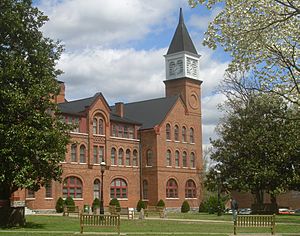
Oklahoma's education system includes public schools and private schools. In 2008, there were 638,817 students in 1,845 public schools. Oklahoma has the highest number of Native American students in the nation.
Oklahoma is known for its pre-kindergarten education. In 2004, it was rated first in the U.S. for its pre-kindergarten standards and access. The high school dropout rate in Oklahoma is low. In 2004, 85.2% of adults had high school diplomas. This was the highest rate among Southern states.
The University of Oklahoma, Oklahoma State University, and The University of Tulsa are some of the largest universities. Northeastern State University is the second-oldest higher education school west of the Mississippi River. It also has the most Native American students. Langston University is Oklahoma's only historically black college.
In 2018, thousands of public school teachers in Oklahoma went on strike. They wanted more funding and higher pay. Oklahoma teachers had ranked 49th in the nation for pay. After the strike, teacher pay improved, and the state's ranking rose to 34th.
Learning Native American Languages

The Cherokee Nation started a plan in 2005 to help more people learn the Cherokee language. They wanted new speakers to learn it from childhood. The Cherokee Preservation Foundation has invested money to open schools and train teachers. They also hold community gatherings where people can use the language.
A Cherokee language immersion school in Tahlequah, Oklahoma teaches students from pre-school through eighth grade.
Oklahoma's Culture and Traditions
Oklahoma is often seen as part of the South, Southwest, Midwest, and Great Plains. Many Oklahomans have English, Scotch-Irish, German, and Native American family backgrounds. There are 25 different Indigenous languages spoken in the state.
Because many American Indian tribes were moved to Oklahoma, the state has a lot of language diversity. However, many of these languages are now in danger of disappearing.
Sixty-seven Native American tribes and bands are represented in Oklahoma. Thirty-eight of these are recognized by the federal government. They have tribal areas in the state. The culture of Oklahoma has been shaped by Native American tribes, Western ranchers, Southern settlers, and Eastern oil barons.
Oklahomans are often known for their "Southern hospitality." In 2004, Oklahomans ranked 7th in the nation for generosity. The state was also linked to a negative stereotype from the 1939 novel The Grapes of Wrath. This book described poor farmers during the Dust Bowl as "Okies." While some Oklahomans use the term positively, many still see it as offensive.
Arts and Entertainment
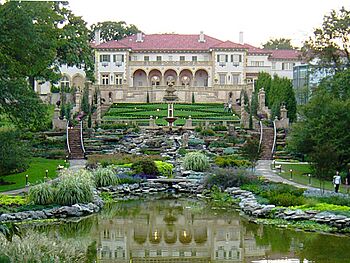
Oklahoma's cities have a lively jazz music scene. African American, Mexican American, and Asian American communities also share their music and art. The Oklahoma Mozart Festival is one of the largest classical music festivals in the region. Oklahoma City's Festival of the Arts is a top fine arts festival.
Oklahoma has a rich history in ballet. Five Native American ballerinas became world-famous. They were Yvonne Chouteau, Marjorie and Maria Tallchief, Rosella Hightower, and Moscelyne Larkin. They are known as the Five Moons. The The New York Times rates the Tulsa Ballet as one of the top ballet companies in the U.S.
Oklahoma has produced unique music styles like The Tulsa Sound and western swing. Cain's Ballroom in Tulsa, known as the "Carnegie Hall of Western Swing," was where Bob Wills and the Texas Playboys played in the 1930s. Stillwater is famous for Red Dirt music.
Oklahoma has many theater companies. These include Lyric Theatre of Oklahoma in Oklahoma City and American Theatre Company in Tulsa.
Oklahoma ranks 17th in the nation for spending on the arts per person. It has over 300 museums. The Philbrook Museum in Tulsa is one of the top 50 fine art museums in the U.S. The Sam Noble Oklahoma Museum of Natural History in Norman is one of the largest university museums. It shows the natural history of the region. The Gilcrease Museum in Tulsa has the world's largest collection of art and artifacts from the American West.
The Mabee-Gerrer Museum of Art in Shawnee has a great Egyptian art collection. The Oklahoma City Museum of Art has the most glass sculptures by artist Dale Chihuly in the world. The National Cowboy & Western Heritage Museum in Oklahoma City explores the history of the American West.
Fun Festivals and Events

Oklahoma's 100th birthday celebration in 2007 was named the top event in the U.S. that year. Many ethnic festivals happen throughout the state. These include Scottish, Irish, German, Italian, Vietnamese, Chinese, Czech, Jewish, Arab, Mexican, and African-American events.
Oklahoma City hosts several annual events. The Oklahoma State Fair attracts about one million people. The annual Festival of the Arts is also popular. Cultural festivals like Juneteenth celebrations are held each year. The Oklahoma City Pride Parade happens every June. The First Friday Art Walk in the Paseo Arts District is a monthly art festival.
The Tulsa State Fair attracts over a million people each year. Tulsa's Mayfest festival and Oktoberfest are also very popular. Tulsa's Oktoberfest was named one of the top 10 in the world by USA Today.
Norman hosts the Norman Music Festival, which features Oklahoma bands. The Medieval Fair of Norman is held annually since 1976. It is Oklahoma's largest weekend event.
Sports in Oklahoma
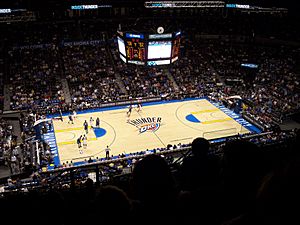
The Oklahoma City Thunder of the National Basketball Association (NBA) is Oklahoma's only major league sports team. The state also has minor league teams in baseball and hockey. These include the Oklahoma City Dodgers (baseball) and the Tulsa Oilers (hockey).
College sports are very popular in Oklahoma. The Oklahoma Sooners and the Oklahoma State Cowboys and Cowgirls are two big college teams. They compete in the top level of college sports. Their football games often have over 50,000 fans. The rivalry between these two universities is called the Bedlam Series.
Two private universities in Tulsa, the University of Tulsa and Oral Roberts University, also have Division I sports teams.
Oklahoma has hosted major golf championships. Southern Hills Country Club in Tulsa is a top golf course. It has hosted five PGA Championships and three U.S. Opens. Rodeos are also popular, with a large one held in Guymon.
ESPN has called Oklahoma City "the center of the softball universe." USA Softball, the sport's governing body, is based there. The USA Softball Hall of Fame Stadium hosts the Women's College World Series every year.
College wrestling is very strong in Oklahoma. Oklahoma State has won the most NCAA national championships in wrestling. The National Wrestling Hall of Fame and Museum is in Stillwater.
Current Professional Sports Teams
| Club | Type | League | Venue | City | Area (Metro/Region) |
|---|---|---|---|---|---|
| Oklahoma City Thunder | Men's Basketball | NBA | Paycom Center | Oklahoma City | OKC Metro |
| Oklahoma City Blue | Men's Basketball | NBA G League | Paycom Center | Oklahoma City | OKC Metro |
| Club | Type | League | Venue | City | Area (Metro/Region) |
|---|---|---|---|---|---|
| Oklahoma City Dodgers | Baseball | PCL (Triple-A) | Chickasaw Bricktown Ballpark | Oklahoma City | OKC Metro |
| Tulsa Drillers | Baseball | DAC (Double-A) | ONEOK Field | Tulsa | Tulsa Metro |
| Club | Type | League | Venue | City | Area (Metro/Region) |
|---|---|---|---|---|---|
| Tulsa Oilers | Hockey | ECHL | BOK Center | Tulsa | Tulsa Metro |
| Club | Type | League | Venue | City | Area (Metro/Region) |
|---|---|---|---|---|---|
| Oklahoma Flying Aces | Indoor Football | CIF | Stride Bank Center | Enid | |
| Oklahoma Thunder | Football | GDFL | Bixby High School | Bixby | Tulsa Metro |
| Oklahoma City Bounty Hunters | Football | GDFL | Putnam City Stadium | Warr Acres | OKC Metro |
| Club | Type | League | Venue | City | Area (Metro/Region) |
|---|---|---|---|---|---|
| FC Tulsa | Men's Soccer | USL | ONEOK Field | Tulsa | Tulsa Metro |
| Tulsa Spirit | Women's Soccer | WPSL | Union 8th | Broken Arrow | Tulsa Metro |
| Oklahoma City FC | Women's Soccer | WPSL | Miller Stadium | Oklahoma City | OKC Metro |
| Oklahoma City Energy | Men's Soccer | USL | Taft Stadium | Oklahoma City | OKC Metro |
| Club | Type | League | Venue | City | Area (Metro/Region) |
|---|---|---|---|---|---|
| Tulsa Rugby Club | Men's Rugby | Division II Rugby | Riverside Pitch | Tulsa | Tulsa Metro |
News and Media in Oklahoma
Oklahoma City and Tulsa are major media markets in the U.S. Broadcast television began in Oklahoma in 1949. All major American TV networks have stations in the state.
Oklahoma has two main newspapers. The Oklahoman in Oklahoma City is the largest. The Tulsa World is the second largest. Oklahoma's first newspaper, the Cherokee Advocate, started in 1844. It was written in both Cherokee and English. In 2006, there were over 220 newspapers in the state.
The first radio station in Oklahoma, WKY in Oklahoma City, began broadcasting in 1920. In 2006, there were over 500 radio stations. Some universities also operate public radio stations.
There are also TV stations that broadcast in Spanish and Asian languages. Some programming is also available in Native American languages.
Getting Around: Transportation in Oklahoma
Oklahoma's transportation system includes Interstate Highways, train lines, airports, and ports. Oklahoma is an important crossroads for U.S. highways. Interstate 35, Interstate 44, and Interstate 40 meet in Oklahoma City. This is a very important intersection for the highway system.
Over 12,000 miles (19,000 km) of roads make up the state's main highway system. This includes state highways and ten toll roads. Oklahoma also has the longest drivable part of Route 66 in the nation. In 2008, Interstate 44 in Oklahoma City was the busiest highway.
Oklahoma's largest airport is Will Rogers World Airport in Oklahoma City. It serves over 3.5 million passengers each year. Tulsa International Airport is the second largest. Oklahoma has over 150 public-use airports.
Oklahoma is connected to the national rail network by Amtrak's Heartland Flyer. This passenger train runs from Oklahoma City to Fort Worth, Texas. There are also two inland ports on rivers: the Port of Muskogee and the Tulsa Port of Catoosa. The Tulsa Port of Catoosa is one of the most inland international ports in the U.S. It connects to the Mississippi River.
Oklahoma's State Symbols
| Dance | Waltz: Oklahoma Wind |
|---|---|
| Bird | Scissor-tailed Flycatcher |
| Fish | Sand bass |
| Flower |
|
| Tree | Redbud |
| Insect | European honey bee |
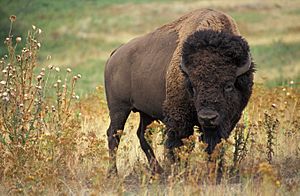
Oklahoma has many official state symbols. These symbols represent the state's history, nature, and culture. The Oklahoma Senate or House of Representatives can also name other symbols for special events.
Images for kids
-
The Dust Bowl sent thousands of farmers into poverty during the 1930s.
-
State rock (rose rock) specimens from Cleveland County, with a US quarter for size reference.
-
The lower dam on Medicine Creek in Medicine Park, below Lake Lawtonka, built c. 1901 to serve the nearby city of Lawton. Medicine Park was one of the first resort communities established in the Wichita Mountains.
-
The Ouachita Mountains cover much of southeastern Oklahoma.
-
Grave Creek in McIntosh County, Oklahoma
-
Populations of American bison inhabit the state's prairie ecosystems.
-
Mesas rise above one of Oklahoma's state parks.
-
Oklahoma's climate is prime for the generation of thunderstorms
-
The Oklahoma State Capitol in Oklahoma City
-
The Boston Avenue Methodist Church in Tulsa is a National Historic Landmark.
-
The Cathedral of Our Lady of Perpetual Help in Oklahoma City
-
The BOK Tower of Tulsa, Oklahoma's second-tallest building, serves as the world headquarters for Williams Companies.
-
Oklahoma's system of public regional universities includes Northeastern State University in Tahlequah.
-
Bizzell Memorial Library, the heart of the University of Oklahoma in Norman
-
Writing in Cherokee
-
The Pioneer Woman statue in Ponca City, by Bryant Baker (1930)
-
Philbrook Museum of Art, one of the nation's top fifty
-
Oklahoma Renaissance Festival, 2017
-
Oklahoma Regatta Festival on the North Canadian River, 2012
-
The Oklahoma City Thunder moved there in 2008, becoming its first permanent major-league team in any sport.
-
The American bison is Oklahoma's state mammal.
See also
 In Spanish: Oklahoma para niños
In Spanish: Oklahoma para niños



